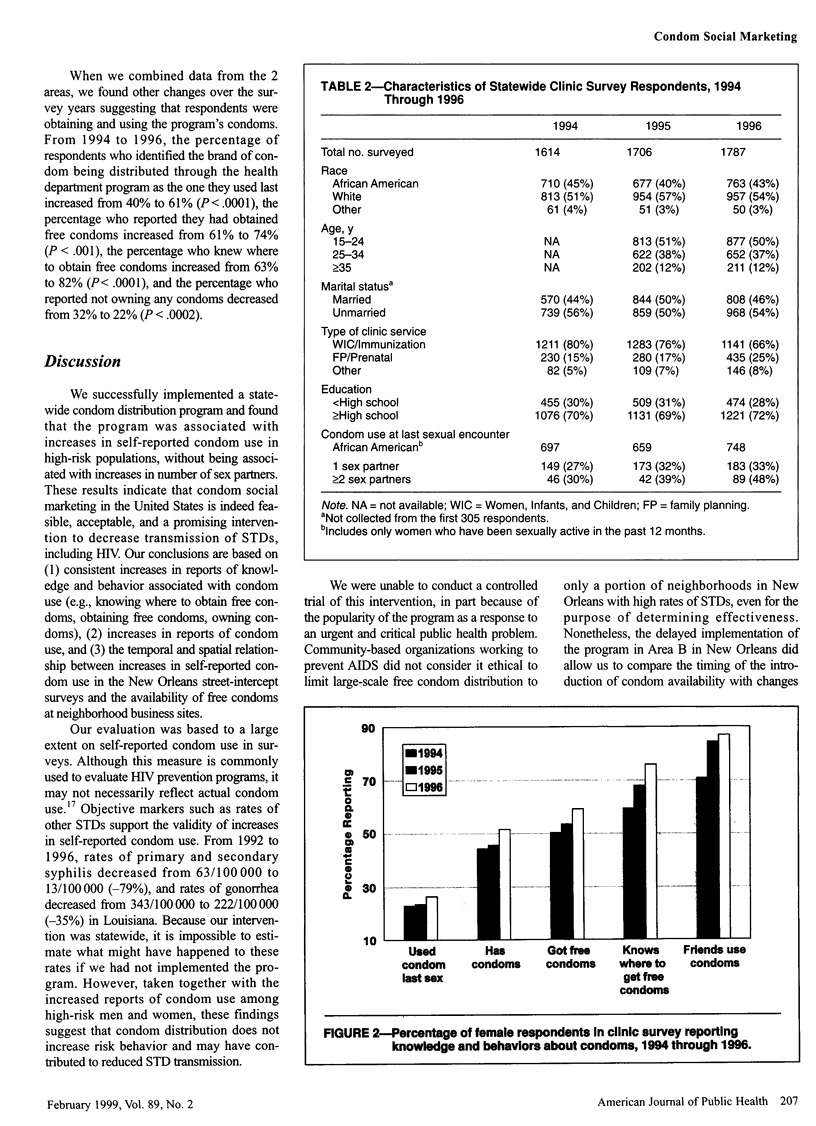Abstract
OBJECTIVES: This article describes the implementation and impact of the first statewide condom social marketing intervention in the United States. METHODS: A statewide social marketing program made condoms freely available in 93 public health clinics, 39 community mental health centers, 29 substance abuse treatment sites, and more than 1000 businesses in neighborhoods with high rates of sexually transmitted diseases (STDs) and HIV. Surveys about condom use were conducted annually. RESULTS: Between 1994 and 1996, more than 33 million condoms were distributed without significant opposition. Over time, self-reported condom use at the last sexual encounter increased among African American women (from 28% in 1994 to 36% in 1996), particularly African American women with 2 or more sex partners (from 30% to 48%). Condom use at the last sexual encounter increased among African American men (from 40% in 1994 to an average of 54% in 1996). The number of reported sex partners did not increase. CONCLUSIONS: Condom social marketing can be successfully implemented in the United States. The widespread availability of free condoms is associated with increased condom use, particularly among persons at high risk for STDs and HIV.
Full text
PDF




Selected References
These references are in PubMed. This may not be the complete list of references from this article.
- Calsyn D. A., Meinecke C., Saxon A. J., Stanton V. Risk reduction in sexual behavior: a condom giveaway program in a drug abuse treatment clinic. Am J Public Health. 1992 Nov;82(11):1536–1538. doi: 10.2105/ajph.82.11.1536. [DOI] [PMC free article] [PubMed] [Google Scholar]
- Catania J. A., Coates T. J., Stall R., Turner H., Peterson J., Hearst N., Dolcini M. M., Hudes E., Gagnon J., Wiley J. Prevalence of AIDS-related risk factors and condom use in the United States. Science. 1992 Nov 13;258(5085):1101–1106. doi: 10.1126/science.1439818. [DOI] [PubMed] [Google Scholar]
- Cohen D. A., Dent C., MacKinnon D., Hahn G. Condoms for men, not women. Results of brief promotion programs. Sex Transm Dis. 1992 Sep-Oct;19(5):245–251. doi: 10.1097/00007435-199209000-00002. [DOI] [PubMed] [Google Scholar]
- Cohen D. A., Farley T. A., Bugg S. Why the U.S. needs a national policy on condoms. AIDS Public Policy J. 1997 Fall;12(3):128–135. [PubMed] [Google Scholar]
- DiClemente R. J., Lodico M., Grinstead O. A., Harper G., Rickman R. L., Evans P. E., Coates T. J. African-American adolescents residing in high-risk urban environments do use condoms: correlates and predictors of condom use among adolescents in public housing developments. Pediatrics. 1996 Aug;98(2 Pt 1):269–278. [PubMed] [Google Scholar]
- Guinan M. E., Farnham P. G., Holtgrave D. R. Estimating the value of preventing a human immunodeficiency virus infection. Am J Prev Med. 1994 Jan-Feb;10(1):1–4. [PubMed] [Google Scholar]
- Heckman T. G., Sikkema K. J., Kelly J. A., Fuqua R. W., Mercer M. B., Hoffmann R. G., Winett R. A., Anderson E. S., Perry M. J., Roffman R. A. Predictors of condom use and human immunodeficiency virus test seeking among women living in inner-city public housing developments. Sex Transm Dis. 1996 Sep-Oct;23(5):357–365. doi: 10.1097/00007435-199609000-00003. [DOI] [PubMed] [Google Scholar]
- Kusseling F. S., Shapiro M. F., Greenberg J. M., Wenger N. S. Understanding why heterosexual adults do not practice safer sex: a comparison of two samples. AIDS Educ Prev. 1996 Jun;8(3):247–257. [PubMed] [Google Scholar]
- Middlestadt S. E., Bhattacharyya K., Rosenbaum J., Fishbein M., Shepherd M. The use of theory based semistructured elicitation questionnaires: formative research for CDC's Prevention Marketing Initiative. Public Health Rep. 1996;111 (Suppl 1):18–27. [PMC free article] [PubMed] [Google Scholar]
- Peterson J. L., Grinstead O. A., Golden E., Catania J. A., Kegeles S., Coates T. J. Correlates of HIV risk behaviors in black and white San Francisco heterosexuals: the population-based AIDS in multiethnic neighborhoods (AMEN) study. Ethn Dis. 1992 Fall;2(4):361–370. [PubMed] [Google Scholar]
- Valdiserri R. O., Arena V. C., Proctor D., Bonati F. A. The relationship between women's attitudes about condoms and their use: implications for condom promotion programs. Am J Public Health. 1989 Apr;79(4):499–501. doi: 10.2105/ajph.79.4.499. [DOI] [PMC free article] [PubMed] [Google Scholar]
- Zenilman J. M., Weisman C. S., Rompalo A. M., Ellish N., Upchurch D. M., Hook E. W., 3rd, Celentano D. Condom use to prevent incident STDs: the validity of self-reported condom use. Sex Transm Dis. 1995 Jan-Feb;22(1):15–21. doi: 10.1097/00007435-199501000-00003. [DOI] [PubMed] [Google Scholar]


